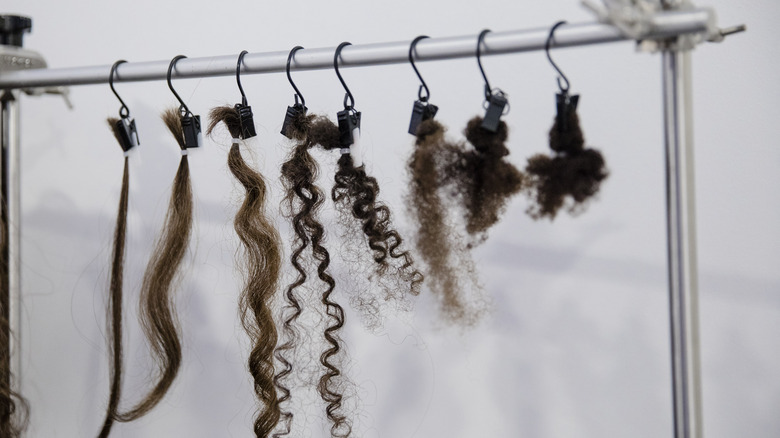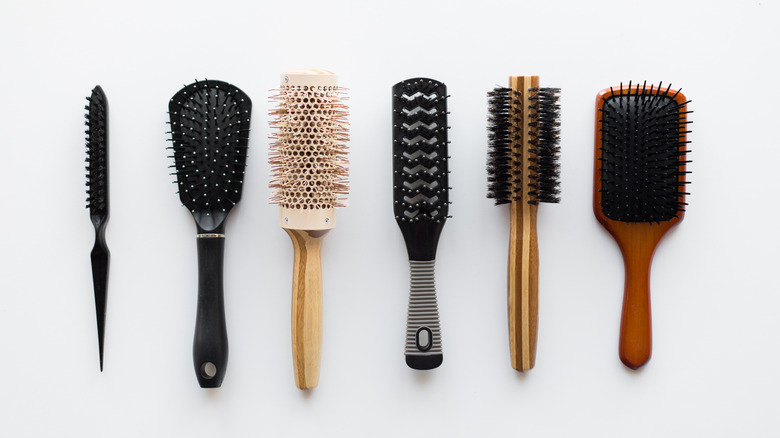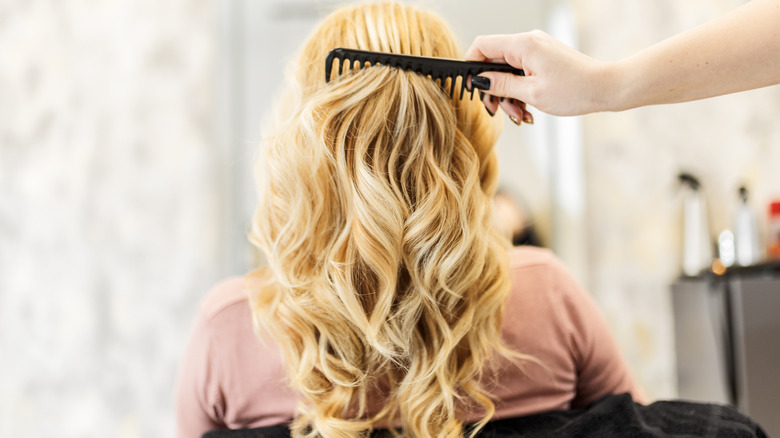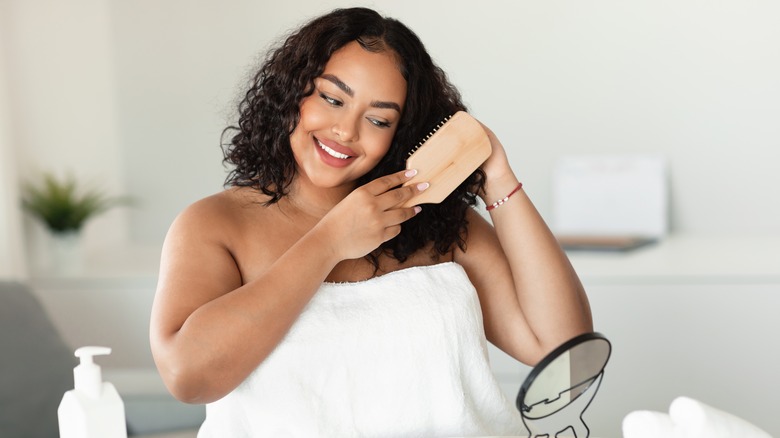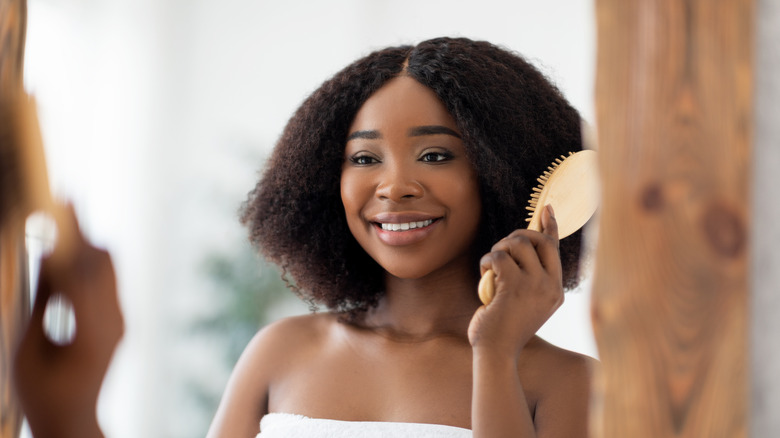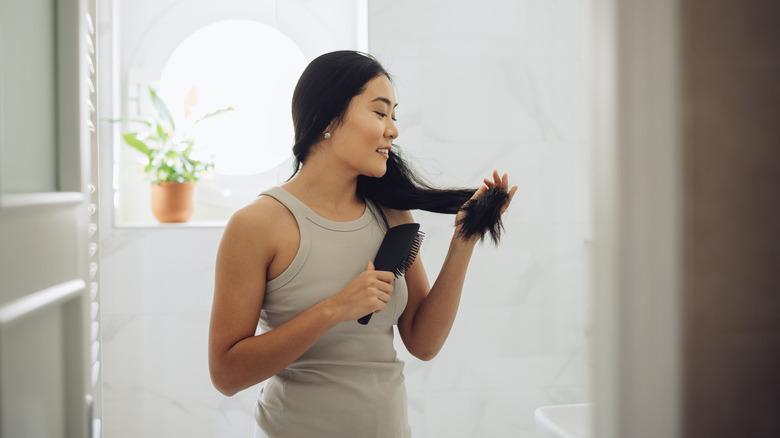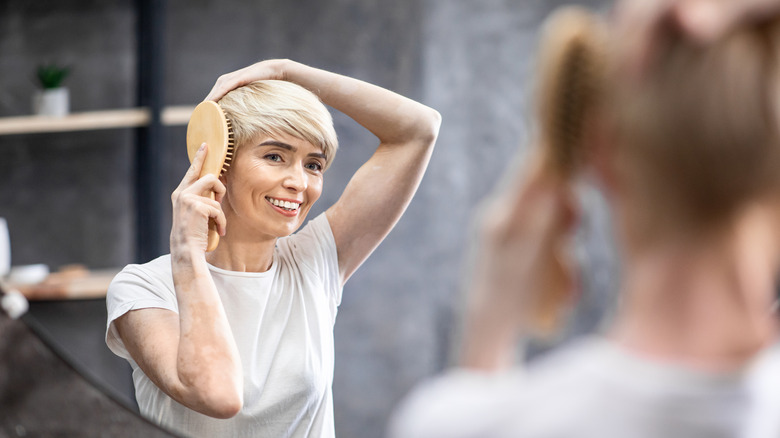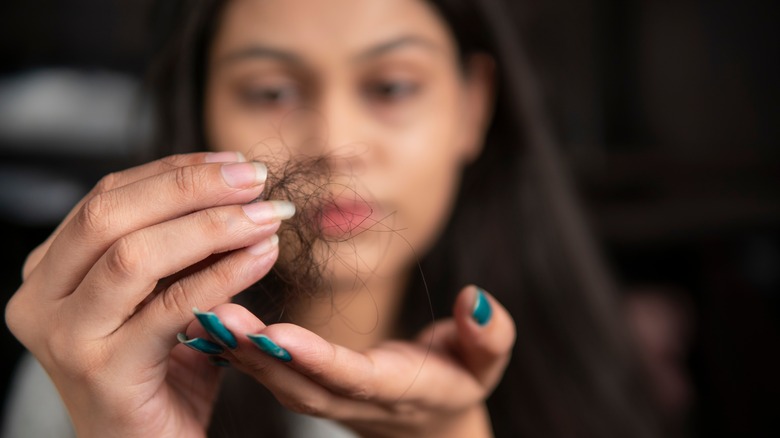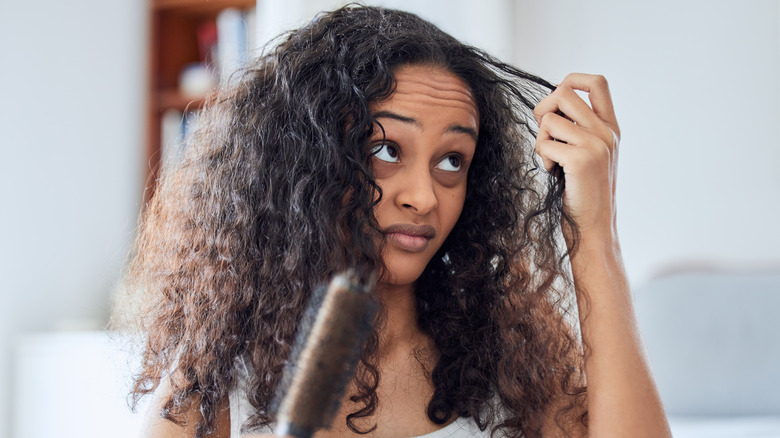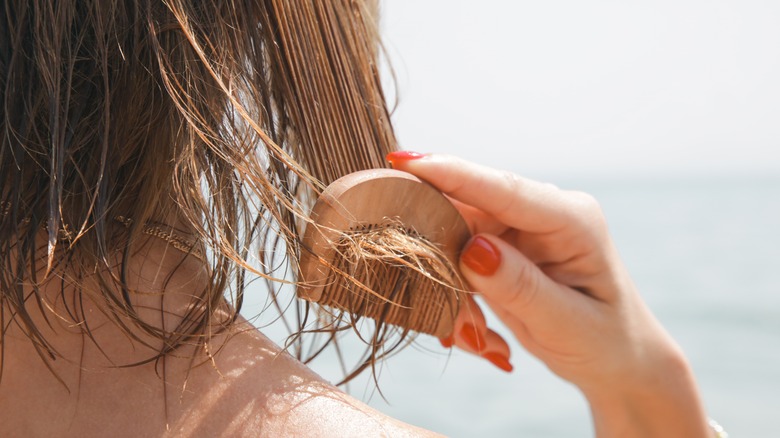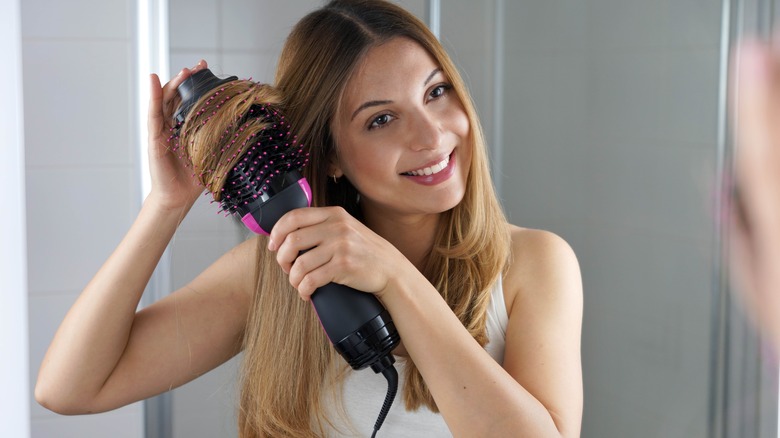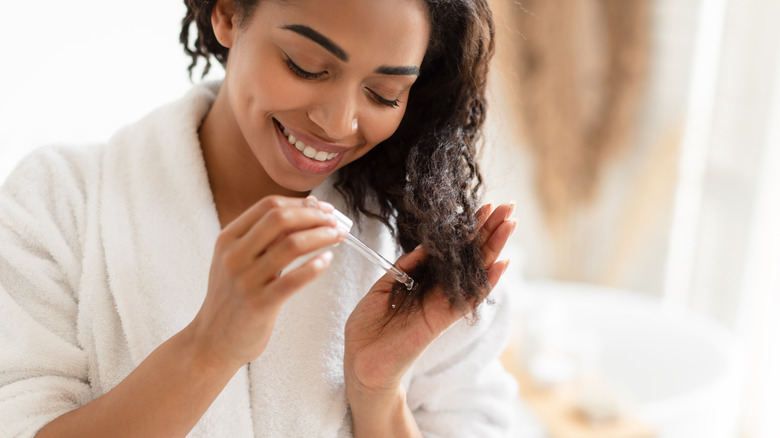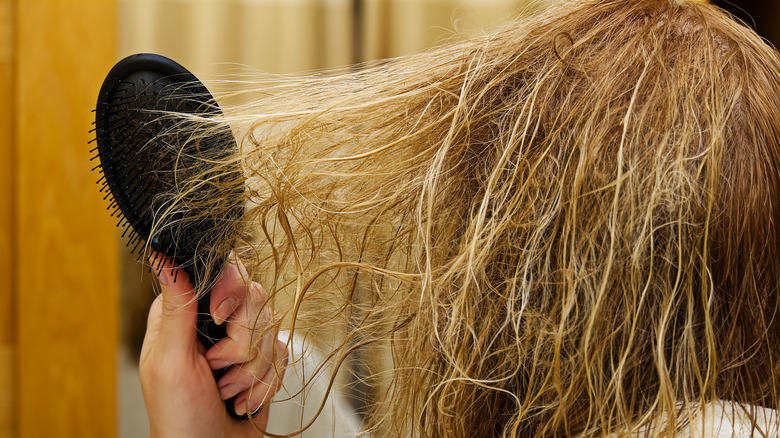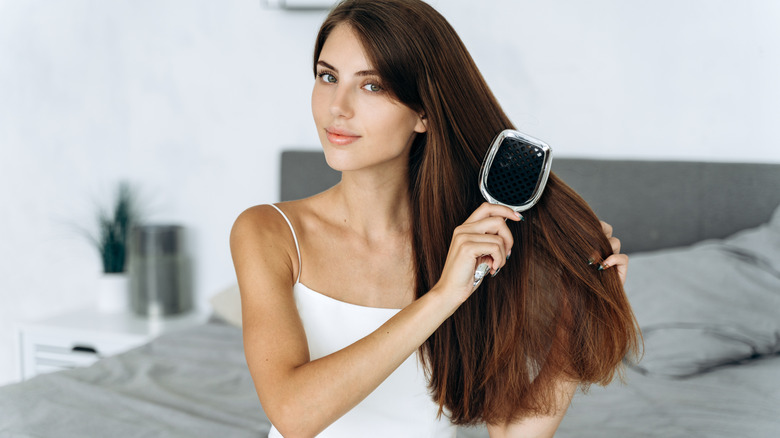Your Ultimate Guide To Brushing Your Hair Type The Right Way
Brushing your hair is one of the most basic ways to detangle and manage it. Apart from keeping the hair in check, brushing has other benefits, too, like spreading your scalp's natural oils and any product you apply around your hair. "Sebaceous glands located in your hair follicles produce natural oils that help lubricate your scalp," celebrity hairstylist and owner of Vincent Hair Artistry Vincent De Marco tells Healthline. "When you brush your hair properly, it helps distribute these natural, healthy oils, from the roots of your hairs to the ends, giving them a natural shine." Brushing also increases blood flow to your scalp, which can improve hair growth. Plus, running your brush one last time through your smooth hair can be super satisfying. But have you ever considered that your current brushing practice might not be doing right by your hair?
One hair mistake that's easy to make is using the wrong hairbrush but expecting the best finish. As with all things haircare, the choice of a brush should depend on your hair's type, thickness, length, and quality. This might all sound overwhelming, so we've done the work for you and rounded up what you need to know about brushing your hair according to your hair type.
Get to know your hair type
Your hair type depends on the structure of your hair. Scalp hair strands are made of three layers — a small inner medulla, an intermediate cortex, and an outer protective cuticle. The cortex is the largest layer of the hair and it's made mostly of keratin. How the cells of the cortex are arranged determines your hair texture, per a 2014 paper published in Peer J.
According to stylist Andre Walker's system, hair is classified as type 1 or straight, type 2 or wavy, type 3 or curly, and type 4 or natural. Each class is further sub-typed as A, B, or C depending on the texture and pattern of the hair. To paint a picture, type 4C hair is the most coily and 2A is the least wavy.
To determine your hair type, you need to observe your hair in its natural state, after it's washed, dry, and free of product. It's best to compare hair in this state to a hair chart. If finding your hair type proves difficult, colorist, curl specialist, and beauty brand diversity and inclusion strategist Keya Neal advises asking a stylist (via Consumer Reports). "And remember, you may have different textures in different places on your head — like tight, coily hair in the back and more loose, curly hair in the front," Neal adds. Importantly, hair can also be oily or dry, thick or thin, and fine or coarse. And these qualities contribute to your overall hair type.
Use the right brush
Hairbrushes usually come in different shapes and sizes and have different bristle types. So, a particular brush will suit one hair type better than another. For instance, paddle brushes are wide and can cover a lot of ground with one swoop. This means they are pretty good for brushing straight hair, especially if it's long and prone to breakage. If your locks tend to get tangled, then a wide-toothed detangling comb is your best option. These combs can be magical for curly hair, particularly when wet. Another great detangling brush is the Denman brush, which is ideal for natural hair.
An important aspect of getting the right brush is noting the type of bristles it has. Boar bristles are soft and gentle, so they work well for fine or weak hair. But if your hair is thick and coarse, then going for stronger and more flexible bristles is better.
Styling brushes or combs should not be used for regular brushing. Your rat-tail comb is best only for parting your hair. Teasing brushes are great for adding volume to your roots, and like a rat-tail comb, they can be used to part the hair. If you have the skill, a round brush can help give you a salon-worthy blowout. But none of these should be used for combing your hair.
Don't be tempted to over-brush straight hair
There are many things that can make straight hair go flat and limp, especially between wash days. It also doesn't help that straight hair tends to be more prone to becoming oily, which makes it likely to be weighed down. Running your brush too many times on one section of your hair can contribute to making it flat, and over-brushing also increases the risk of hair breakage because it involves you tugging unnecessarily on your hair strands. In addition to brushing less, you should go for a brush with soft bristles if you have straight hair. They help distribute hair oils without being too hard on your cuticles.
If you're brushing straight hair, you might want to give it some volume and body. A simple trick is to use a teasing brush to raise your roots. You can add a styling spray to make the look stick. Another way to add volume is to part your hair to one side.
A comb is better for wavy hair
For those styling naturally wavy hair, keeping the hair frizz-free and the waves well-defined can be a challenge. Brushing can disrupt your wave patterns and cause hair frizz, particularly when your hair is damp. To protect your waves, consider replacing your brush with a wide-toothed comb, which will detangle your hair without turning it to frizz. You can also use your fingers to gently comb through your hair before using a detangling comb.
If you want to use a traditional brush on wavy hair, you just need to be extra careful to protect your waves. First off, you shouldn't brush your hair when wet. You should also make sure to detangle your hair before you brush it. And when you do, it's best to work in sections and brush gently starting from your tips and working your way up. The type of bristle of your brush also matters. You should avoid hard materials like plastic. Instead, go for soft, flexible, bristles like boar bristles, as they can glide easily through the hair without altering the wave pattern.
Curly hair is best brushed when damp
Like wavy hair, curly hair is prone to losing its curl pattern and getting frizzy when brushed improperly. Using a spray bottle or a few handfuls of water can go a long way to help. Wetting the hair also makes it easier to detangle. On the other hand, you may end up tugging at tangled portions of hair when you dry-brush it. This could leave you with more clumps of hair in your brush than you might prefer. If you don't enjoy wetting your hair, you can use a product that adds a bit of slip to the hair when brushing. This could be a good hair oil, moisturizing cream, leave-in conditioner, or detangling spray.
As for the right bristles, go for those made with nylon. They have a smooth surface and can glide through the hair. In general, you should avoid brushes with roughly textured bristles if your curly hair is tighter. You should also be mindful of bristle spacing. Dense bristles flatten the hair, which can mess with your curl pattern but is ideal for a slicked-back look.
Detangling is a must for natural hair
The truth is any hair type would benefit from detangling before brushing. But detangling is really important for natural hair, since it helps to fend off breakage and allows any haircare products to reach the entire strand of hair. Moisture is often required for detangling this hair type, especially at the more fragile tips, as drier hair is more prone to tangling. This could involve simply wetting the hair with water. But to get that much-needed slip, it's best to use products like detangling sprays, leave-in conditioners, or hair oils.
The best tools in your natural hair arsenal are your fingers. Use them to remove any shed hair strands and detangle tight knots. You can go for a Denman brush or wide-toothed comb to give your hair a proper finish depending on your needs. Whatever you choose, avoid combs with close teeth or brushes with tight bristles. They are harder to run through your hair and so can cause hair breakage. Additionally, always detangle your hair tips first before working up to the roots to prevent breakage.
The tip to root technique is sacred for long hair
Irrespective of your hair length, it's advisable to start brushing your hair by detangling your tips. But if you have long hair, never get tempted to run your brush straight from your roots without detangling your tips first. Chances are, you would lose more hairs to breakage this way, as you're just pushing knots into other knots that exist further down the hair shaft, creating one big problem to deal with at the ends. It's also best to work in sections for long thick hair.
Using the right hair brush can make your job a lot easier if you have long hair. Large brushes such as paddle brushes are great for long hair. This is because they can cover a larger surface than small brushes. You should go for bristles that best suit your hair type, regardless of how long your hair is. That is, look for bristles that glide through your hair easily and distribute hair oils or products properly. Brushing long hair requires some effort, particularly if you have thick and textured hair, so reach for products that increase slip and make the task easier.
Go easy on short hair
From the classic bob to a short shag cut or a pixie cut, short hair styles are great and usually easy to take care of and style. Another great thing about having short hair is that you don't have to put so much effort into brushing or detangling your hair. For really short and manageable hairstyles, all you might need is a little finger toss and you're good to go. If your hair is short, brushing too many times puts stress on your cuticles and scalp. Why put your hair through that if you can avoid it?
Short hair is less likely to tangle than longer hair. But this doesn't mean you should throw out your brushes because you're rocking a short style. Your hairs run the risk of getting matted when you don't brush them at least once in a while. Just go for a tool that is great for your hair type.
Be gentle when brushing thinning hair
Increased hair breakage is a big problem for those with thinning hair, or those with female hair loss. This can be worsened by the wrong brush or brushing technique. Ultimately, thinning hair is fragile, so brushing vigorously can damage the hair cuticle and expose the hair to further damage. This leads to worse hair shedding, especially if the hair gets tangled easily.
For thinning hair, it's best to go for a brush that covers a large surface to avoid repeated brushing. Also, brushes with soft bristles help to prevent excessive tension to the hair. When selecting a brush, avoid those with long bristles. "The length of the bristle matters when it comes to creating tension and [pulling] on the hair. If you experience hair thinning, stay away from brushes that pull tightly at the root," professional hair stylist Fabio Scalia tells She Finds. "The most important thing to remember is to feel the tension the brush creates during use. If you feel like it's pulling too hard, stop using it," he advises. Instead, you should go for bristles that are short and widely spaced. It's also good to go for brushes that massage the scalp as they stimulate hair growth.
The right brush can help tame frizzy hair
Brushing hair the right way can help with frizz-prone hair, which can be linked to cuticle damage. "When examined under a microscope, a healthy cuticle lays down smooth, like the scales of a fish," director of technical training at Hair Cuttery Family of Brands Steve Waldman explains to Healthline. Your scalp oils help with this. However, "as hair becomes dry and damaged, its appearance resembles a pine cone: open, rough and prickly," Waldman adds. In this state, the hair loses its own moisture and oils easily. And when the weather is humid, it absorbs moisture and air and puffs up, giving you frizzy hair
There sure are many products that promise to tame frizzy hair. But one of the easiest changes you can make is to get a proper brush. This should be a brush that doesn't damage your cuticles. The best anti-frizz brushes are made with boar bristles because they minimize cuticle damage. They are also good at distributing oil produced by your scalp to the tips of your hair, giving you a sleek finish.
Be careful with wet hair
Ever heard that crunching sound when brushing your wet hair? Then, you need to reconsider brushing your hair when wet, especially if you have straight hair. This is because straight hair breaks easily when wet. "Curly hair, on the other hand, can be tough to get through when it's dry and is much easier to manage when it's wet," brand ambassador for Matrix George Papanikolas tells Makeup.com. "Allow your [straight] hair to naturally air dry for a few minutes before starting to brush the hair." It's also important to detangle your hair gently with a wide-toothed comb, detangling brush, or your trusty fingers. After detangling you can go in for a blow dry or let your hair air dry.
To lessen the burden of detangling following a hair wash, Papanikolas advises against roughing up the hair with reckless abandon while shampooing or conditioning. A better alternative is to apply shampoo from your roots to tips without squeezing your hair into a ball. Another tip to avoid tangled hair is to brush your hair before you hop into the shower or pool.
How to use a blow dryer brush
A blow dryer brush is the union of the round brush and blow dryer. Its purpose is to reduce the stress of getting a beautiful wavy blowout. This tool requires some skill to use. But once mastered, you can easily make beach waves out of your straight hair, or re-define your wave pattern if you have wavy hair, without stepping out of the house.
Before you reach for your blow dryer brush, it's best to properly detangle the hair for a knot-free styling process. You should also apply heat protectant and any styling products. Finally, start the process when your hair is damp and not wet.
To use the brush, take a small section of your hair and wrap it around the brush from tips to roots. Fire up the brush and hold it at your roots for some time. Then, rotate the brush as you release it from your hair to create waves. Some brushes have an auto-rotate feature just for this. To finish up the process, turn on the cold shot button. "This will help to seal the cuticle of the hair shaft, preventing moisture from getting into it and causing unwanted frizz," stylist and BaByliss ambassador Syd Hayes advises Woman and Home. Lastly, remember to apply your best finishing product when you're done.
Using the right products can make detangling easier
There are several products that take the stress away from detangling and brushing, and the most basic one is a good conditioner. While there are different kinds of conditioners, they all serve to balance shampoo chemicals, soften the hair, smoothen hair cuticles, and increase the hair slip, according to a 2023 study published in Polymers. These help make it easy to detangle, brush, and style the hair.
If your hair is really dry and damaged, it can benefit from a deep conditioner, which is stronger than an instant conditioner. Deep conditioner "will not only stabilize the hair's pH, but work to rebuild compromised protein structure, increase hair's elasticity and enhance moisture retention overall," explains hairstylist and Matrix artistic director Nick Stenson (via Makeup.com). Another alternative is a leave-in conditioner, which is a lighter-weight option that can be applied after a hair wash or when the hair is dry. Note that people with wavy, curly, or natural hair may need extra help to detangle it. This could come from simply wetting the hair or using products like hair oils, hair masks, or detangling creams or sprays.
What to do when your hair gets tangled in your brush
With the right technique, you may not need to cut off your precious locks when your hair gets tangled in your brush. For starters, you shouldn't pull the brush or your hair and worsen the situation, per Tangle Angel. Just like getting any other thing unstuck, you need to lubricate, particularly if you have dry or coarse hair. You can do this by spraying a little water or rubbing hair oil through your strands.
Next, try to gently ease the hair out of your brush, starting with the outermost sections. Don't tug, especially if your hair is fine, damaged, or thinning. The pointy end of a rat-tail comb can help with this. You can also use a detangling spray or a hair dryer to heat up your hair to ease the process. If this doesn't work, ask someone to use a pair of scissors to carefully cut off the bristles of your brush. If you still can't detangle your hair, seek professional help at the salon. Note that if your hair tends to get stuck in your brush, it could be that the brush is small or the bristles are too hard on your hair.
Don't give your hair 100 brush strokes a day
This is one hair styling myth that promises to make your hair healthy, long, smooth, and shiny. But what's more likely is that you'll end up with damaged hair. The American Academy of Dermatology advises against this, stating that you only need to brush your hair to style it and this certainly won't require 100 strokes. Sure, brushing your hair helps distribute hair oils to your hair tips, but brushing too much can lead to damage and split ends.
How often you should brush your hair during the day depends on your hair type. Folks with thick, long, straight hair can get away with brushing up to three times a day. People with curly and natural hair can benefit from brushing the hair when damp and styling it in a protective hairstyle. If your hair is on the thin side, though, you only need to brush it once or twice a day.

